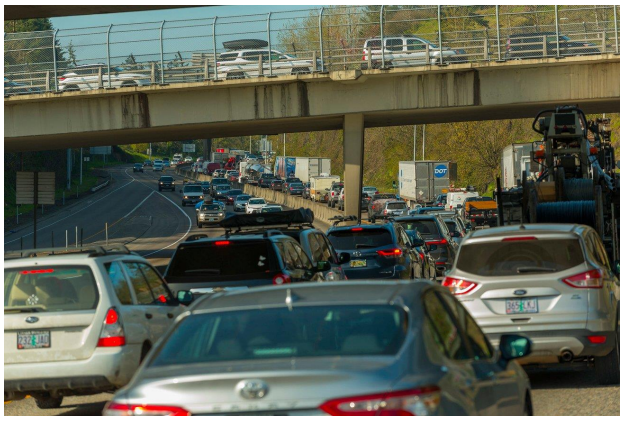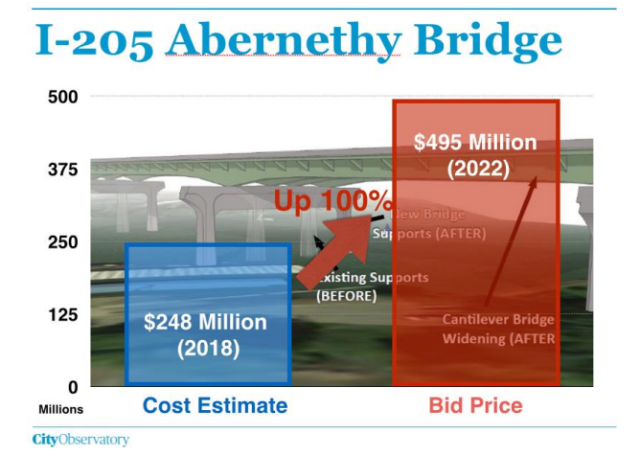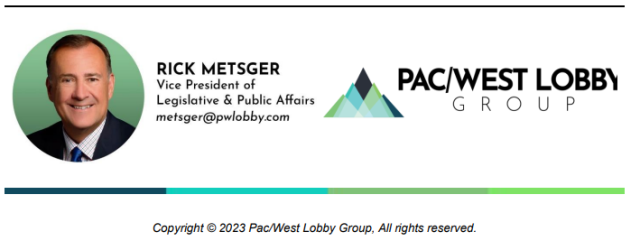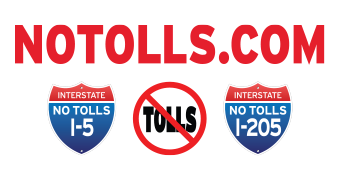Reducing Congestion and Funding Construction Can’t Be Achieved With Tolling
From The Political Center at PacWest Lobby
Full disclosure: The Oregon Department of Transportation (ODOT) is not to blame for all its
fiscal problems. The legislature is primarily responsible as the dealer that got the agency
addicted to bonded indebtedness. As chairman of the Senate Transportation Committee
for almost a decade and co-author of the OTIA and JTA legislation of the 2000s, I own a
share of the responsibility.
Before 2001, ODOT operated as a pay-as-you-go agency. Indebtedness was very limited.
In 2009, Vice-Chair Sen. Bruce Starr (R-Hillsboro) and I created the massive Jobs &
Transportation Act to put people back to work after the Great Recession of 2008. We
enacted revenue increases to pay debt service for important projects. Those revenues
matched the estimated costs as provided by the department. Unfortunately, those
estimates proved to be not just rosy but wildly unrealistic.
In some cases, the final cost to completion came to 200% or more above original
estimates, and the revenue raised could only partially support the final tab. ODOT dipped
into money needed for maintenance, preservation, and other needs, along with federal
grants and local government support to keep the projects online. Some, like the final
stages of the Newberg-Dundee Bypass, are still not completed. ODOT’s debt is approaching
30% of its existing yet declining revenues.
As the chairman, my committee at the time relied on ODOT estimates without applying the
scrutiny those estimates deserved. Today, current project cost estimates for the
Abernethy Bridge, Rose Quarter, and I-5 Bridge replacement are already 200-300% above
the original estimate and are likely to balloon even higher. I hope that this Legislature will
learn from that history and not embark on policies that risk the financial stability of ODOT
while meeting, in a measured and thoughtful way, the many transportation needs of this
state.
When the Oregon Legislature authorized tolling in a section buried deeply in the catacombs of a
huge transportation package bill (HB 2017 Section 120) late in the 2017 session, there was
virtually no debate between committee members. There was barely even an acknowledgment of
the provision’s existence during the seven meeting dates the bill was heard. There were,
however, almost 12 hours of praise heaped upon the many excellent provisions in the bill, from
transit and pedestrian enhancements to money for ports and local governments. Amens were all
that could be heard echoing off the hearing room walls.
Perhaps it was the crafty code that was used. The provision created the “Congestion Relief
Fund.” Who would question congestion relief? Everyone needs a dose of NyQuil on occasion.
The fact is, it authorized tolls and the money was directed to the fund solely to provide congestion
relief. Such tolling can be done in moderation and at a low cost to motorists while still achieving
the desired results.
Having achieved the legislative authorization needed to toll Oregon highways, ODOT returned in
2021 and quietly and unassumingly swapped out the artwork. Again, near the end of a bill the
size of a James Michener novel, ODOT added “technical changes” that, in reality, repealed the
“Congestion Relief Fund” (SECTION 139. (1) The Congestion Relief Fund, established under
ORS 383.155, is abolished.) and replaced it with the “Toll Program Fund.” The change was a
substantive one. The one and only purpose of the fund was no longer to reduce congestion.
Language saying the fund was to ‘reduce traffic congestion’ was deleted in Section 146 and
replaced with ‘managing’ congestion. That’s like changing goals from “reducing homelessness” to
“managing homelessness.”
ODOT then added as a primary purpose: (b) Partially or wholly funding the construction,
operation, or maintenance of a highway sec 146.
1000 Friends of Oregon picked up the change and testified that the language should be returned
to “congestion relief” and not as a funding source for more mega projects. The plea was not
answered.
The two mandates of reducing congestion while maximizing revenue conflict with each other.
Reducing congestion means efforts to keep people off the freeway during peak hours. Raising
revenue relies on getting as many cars as possible to take the freeway in peak hours to collect
tolls.

But there is a solution that addresses congestion without sending drivers to the local payday
lender — altering the legislation to design a Hybrid Cordon pricing plan for the region. This would
include:
- Putting a single toll area on the four major highways, including Highway 26 west
towards Hillsboro, I-84 east towards Gresham, and I-5 and I-205. - The toll would only be operational during established peak hours of 5-10 a.m. and
3-7 p.m. - Motorists can travel in the zone for free 16 hours a day.
- Once a single toll is collected on any freeway, it negates all other toll zone
impositions during that day.
Considering that 140,000 people a day travel into Portland from Vancouver, 100,000 more come
from the south, and 230,000 drivers enter the zone from the combination of I-84 and HWY 26,
just a 10% traffic reduction during peak hours could reduce congestion by up to 30%. There
would be far fewer diversions or neighborhood impacts because of the zoned toll, but fewer than
there would be under the current plan to charge a toll for every mile driven on I-5 and I-205.
ODOT could be restricted from using toll revenues as support for bonds and instead dedicate the
money to maintenance and preservation. The agency testified last week that this is the area that
their fiscal distress has most impacted. Bonding for new and rebuilt infrastructure can use
existing revenue sources and ramp up the agency’s lobbying effort in Washington, D.C., to
acquire some of the additional $43 billion in transportation grant money available for state
projects.
Rather than operating in silos, imagine if the Oregon and Washington delegations joined
together for a Northwest Transportation Infrastructure Initiative and used their collective
political clout to secure a nice piece of that $43 billion for the plan as one applicant.
As for the immediate issue of how to pay for the construction of the Abernethy Bridge that is
already underway through using a credit card? A simple two-cent increase in the gas tax ($32
million annually), entirely dedicated to Abernethy Bridge debt service, would solve that issue. At
the same time, projects like adding lanes to I-205 at Tualatin and updating the Boone Bridge can
be put in the back pocket until the Legislature weighs in on a long-term funding strategy for the
agency.

ODOT should also get aggressive about developing a long-term funding plan (VMT, Electricity
surcharges, state transportation tax, etc.) for consideration by the Legislature to replace the
slowly dying gas tax.
A better way is right before us. Oregon must take the off-ramp from the current plan of tolling
every mile, return focus to the original core issue of reducing congestion, and develop and
implement a long-term strategy to fund the transportation needs of this state, as called for by
Gov. Tina Kotek. If not, we face the genuine threat that a citizen initiative already in the works will
constitutionally all but take the tolling option away from policymakers to use for any purpose,
including replacing the interstate bridge.
Leaders today must ask themselves, “Do we take a proactive step towards solving congestion
surgically or stay back in the shadows and deal with the aftermath of inaction that is sure to come
if the plan is not altered now?”
(Editor’s Note from Part 1: Pioneer Ferry operator Jesse Boone was killed in 1872, not 1972)



